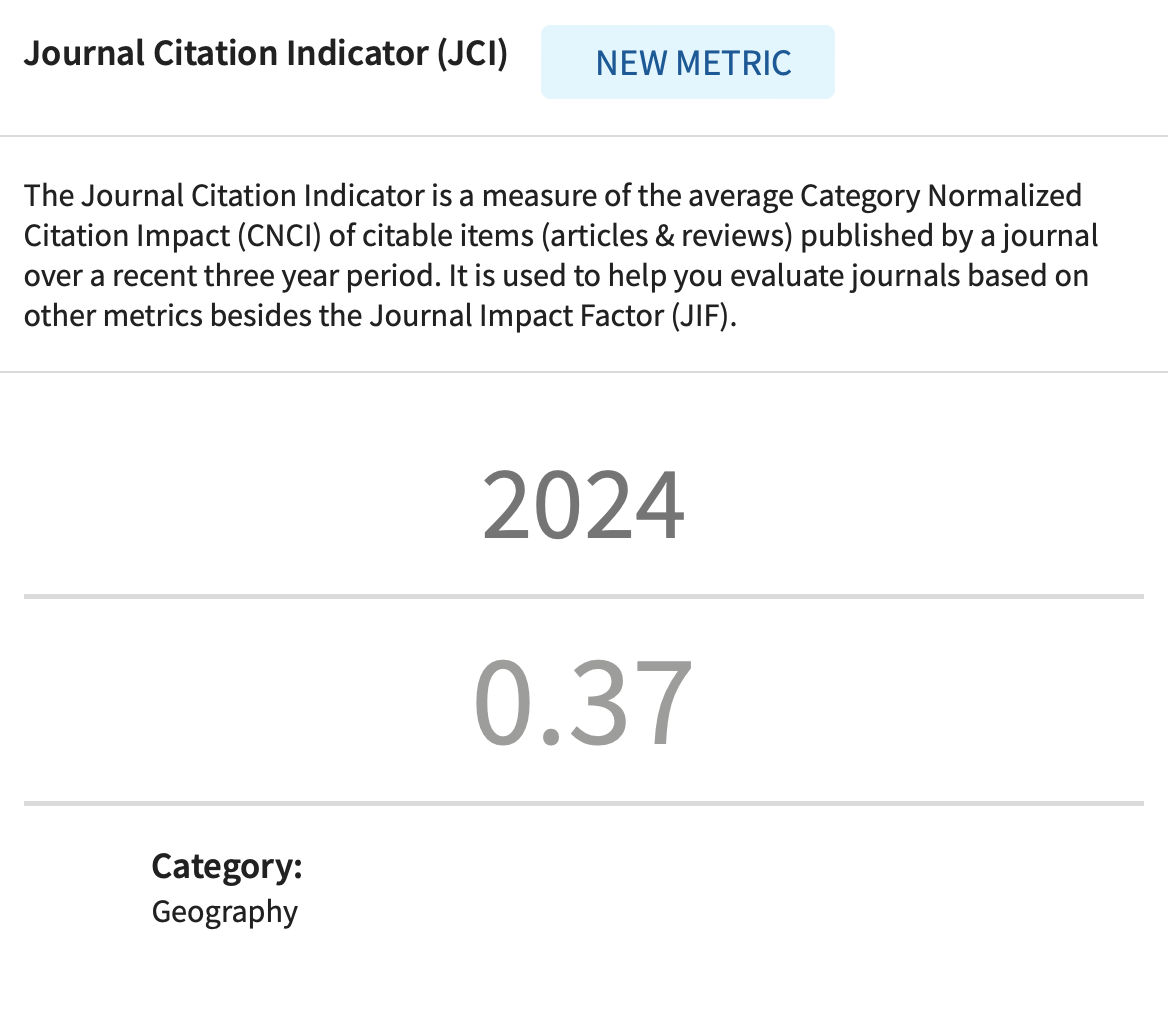MEASURING SPATIAL SEGREGATION OF ROMA NEIGHBORHOODS IN URBAN SETTLEMENTS: CASE STUDY OF RUSE, BULGARIA
DOI:
https://doi.org/10.2298/IJGI2501121IKeywords:
ghettoization, segregation assessment, Roma population, urban development, BulgariaAbstract
Post-socialist European cities face many challenges, such as growing socioeconomic inequality, spatial polarization, and a lack of sustainability. The rise of Roma ghettoized quarters in the cities imperatively imposes comprehensive research on the origin, evolution, and significance of these areas in the urban fabric. These ghettoized neighborhoods deepen the social, economic, and spatial divisions between citizens and significantly influence urban development and policy. Adapting the model developed by Divyani Kohli and coauthors in 2012, this study proposes a modified conceptual framework and index for assessing the spatial segregation of Roma neighborhoods in Bulgaria, using the four Roma settlements in the city of Ruse as a case. It aims to facilitate the elaboration of effective policies for integrated and sustainable urban development. The research utilizes quantitative and qualitative methods, including participant observation, in-depth interviews, and the analysis of normative documents, remote sensing, and geographic information systems (GIS), to collect detailed spatiotemporal data on Roma neighborhoods and calculate an index reflecting their urban design. Applying the index to the case of Ruse, the Selemetya neighborhood emerges as the most distinct and segregated Roma neighborhood, while the other three neighborhoods exhibit features of partial segregation. Despite the fact that the level of spatial segregation of Roma neighborhoods can be measured based on various approaches and criteria, the suggested index, despite its shortcomings, can be considered appropriate, although not universal, and therefore, the local specifics of deprived areas should be taken into consideration.
Article metrics
References
Berescu, C. (2011). The rise of the new European Roma ghettos: A brief account of some empirical studies. Urban Research & Practice, 4(3), 344–352. https://doi.org/10.1080/17535069.2011.616750
Brown, L. A., & Chung, S.-Y. (2006). Spatial segregation, segregation indices and the geographical perspective. Population Space and Place, 12(2), 125–143. https://doi.org/10.1002/psp.403
Creţan, R., & Turnock, D. (2008). Romania’s Roma Population: From Marginality to Social Integration. Scottish Geographical Journal, 124(4), 274–299. https://doi.org/10.1080/14702540802596608
Davinić, M. (2016). The Legalization of Informal Roma Settlements in the Republic of Serbia: A Necessary Step Prior to Legitimation. Annals Belgrade Law Review, 64(1), 132–153. https://doi.org/10.5937/AnaliPFB1601132D
European Commission. (n.d.). Roma equality, inclusion, and participation by EU country. https://commission.europa.eu/strategy-and-policy/policies/justice-and-fundamental-rights/combatting-discrimination/roma-eu/roma-equality-inclusion-and-participation-eu-country_en
European Commission. (2020). Roma Civil Monitor. A synthesis of civil society’s reports on the implementation of national Roma integration strategies in the European Union: Assessing the progress in four key policy areas. https://cps.ceu.edu/sites/cps.ceu.edu/files/attachment/basicpage/3172/rcm-civil-society-monitoring-report-synthesis27-2019-eprint-fin.pdf
Francini, M. C. (2013). Segregation Policies in Sweden & Italy (Master thesis, Blekinge Institute of Technology). https://www.diva-portal.org/smash/get/diva2:832901/FULLTEXT01.pdf
Geodesy, Cartography and Cadastre Agency of the Republic of Bulgaria. (n.d). KAIS – Portal for Electronic Administrative Services [Data set]. https://kais.cadastre.bg/en
Horňák, M., Hluško, R., Rochovská, A., & Lelkesová, V. (2023). Public transport accessibility and spatial exclusion in Roma settlements: A case study of three regions in Eastern Slovakia. Moravian Geographical Reports, 31(1), 27–38. https://doi.org/10.2478/mgr-2023-0003
Ilieva, N. (2013). Romite v Bulgaria. Broi i lokalizatsia ot Osvobozhdenoeto (1878) do nachaloto na XXI vek [The Roma people in Bulgaria - their number and localization, from the Liberation (1878) until the beginning of the 21st century]. National Institute of Geophysics, Geodesy and Geography - Bulgarian Academy of Sciences.
Ilieva, N. (2019). Prostranstvena segregatsia. Teoretichni aspekti [Spatial segregation. Theoretical aspects]. National Institute of Geophysics, Geodesy and Geography - Bulgarian Academy of Sciences.
Ilieva, N. (2022). Grad v grada [City in the City]. National Institute of Geophysics, Geodesy and Geography - Bulgarian Academy of Sciences.
Ilieva, N., & Bardarov. G. (2020). (Ne)vazmozhnata romska integratsia: demografski spetsifiki [(Im)possible Roma integration: demographic peculiarities]. Friedrich Ebert Stiftung.
Ilieva, N., & Kazakov, B. (2019). Projections of the Roma population in Bulgaria (2020-2050). In 5th International Scientific Conference Geobalcanica 2019 (pp. 271–280). http://dx.doi.org/10.18509/GBP.2019.35
Integriran Plan za Gradsko Vuzstanoviavane i Razvitie na grad Ruse 2014-2020 [Integrated Plan for Urban Reconstruction and Development of the Ruse City 2014-2020]. (2013). https://obshtinaruse.bg/integriran-plan-za-gradsko-vazstanovyavane-i-razvitie
Kohli, D., Sliuzas, R., Kerle, N., & Stein, A. (2012). An Ontology of Slums for Image-Based Classification. Computers, Environment and Urban Systems, 36(2), 154–163. https://doi.org/10.1016/j.compenvurbsys.2011.11.001
Kuffer, M., Pfeffer, K., & Sliuzas, R. (2016). Slums from Space - 15 Years of Slum Mapping Using Remote Sensing. Remote Sensing, 8(6), Article 455. https://doi.org/10.3390/rs8060455
Liu, R., Kuffer, M., & Persello, C. (2019). The Temporal Dynamics of Slums Employing a CNN-Based Change Detection Approach. Remote Sensing, 11(23), Article 2844. https://doi.org/10.3390/rs11232844
Málovics, G., Creţan, R., Méreiné Berki, B., & Tóth, J. (2019a). Urban Roma, segregation and place attachment in Szeged, Hungary. Area, 51(1), 72–83. https://doi.org/10.1111/area.12426
Málovics, G., Creţan, R., Méreine-Berki, B., & Tóth, J. (2019b). Socio-environmental justice, participatory development, and empowerment of segregated urban Roma: Lessons from Szeged, Hungary, Cities, 91, 137–145. https://doi.org/10.1016/j.cities.2018.11.013
Marcińczak, S. (2007). The socio-spatial structure of post-socialist Łódź, Poland. Results of national census 2002. Bulletin of Geography. Socio-Economic Series, 8, 65–82. https://doi.org/10.1515/2431
Marcińczak, S., Tammaru, T., Novák, J., Gentile, M., Kovács, Z., Temelová, J., Valatka, V., Kährik, A., & Szabó, B. (2014). Patterns of Socioeconomic Segregation in the Capital Cities of Fast-Track Reforming Postsocialist Countries. Annals of the Association of American Geographers, 105(1), 183–202. https://doi.org/10.1080/00045608.2014.968977
Marushiakova, E., & Popov, V. (1997). Gypsies (Roma) in Bulgaria. Peter Lang Verlag
Méreiné-Berki, B., Málovics, G., & Remus, C. (2021). “You become one with the place”: Social mixing, social capital, and the lived experience of urban desegregation in the Roma community. Cities, 117(3), Article 103302. https://doi.org/10.1016/j.cities.2021.103302
Municipality of Ruse. (2021). Plan za integrirano razvitie na obshtina Ruse 2021–2027 [Plan for Integrated Development of the Municipality of Ruse 2021–2027]. https://www.strategy.bg/StrategicDocuments/View.aspx?lang=bg-BG&Id=1529
Municipality of Ruse. (2022). Plan za deystvie na Obshtina Ruse (2022-2023) v izpalnenie na natsionalnata strategia na Republika Bulgaria za ravenstvo, priobshtavane i uchastie na romite (2021-2030) [Ruse Municipality Action Plan (2022-2023) in implementation of the National Strategy of the Republic of Bulgaria for Roma Equality, Inclusion and Participation (2021-2030)]. https://obshtinaruse.bg/plan-za-deystvie-na-obshtina-ruse-2022-2023-g-v-izpalnenie-na-natsionalnata-strategia-na-republika-bulgaria-za-ravenstvo
Munté-Pascual, A., Khalfaoui, A., Valero, D., & Redondo-Sama, G. (2022). Social Impact Indicators in the Context of the Roma Community: Contributions to the Debate on Methodological Implications. International Journal of Qualitative Methods, 21, Article 16094069211064668. https://doi.org/10.1177/16094069211064668
Musterd, S. (2005). Social and Ethnic Segregation in Europe: Levels, Causes, and Effects. Journal of Urban Affairs, 27(3), 331–348. https://doi.org/10.1111/j.0735-2166.2005.00239.x
National Statistical Institute of the Republic of Bulgaria. (2021a). Ethno-cultural characteristics of the population as of September 7, 2021. Final data. https://www.nsi.bg/sites/default/files/files/pressreleases/Census2021-ethnos_en.pdf
National Statistical Institute of the Republic of Bulgaria. (2021b). Census 2021 – Results [Data set]. https://infostat.nsi.bg/infostat/pages/module.jsf?x_2=338
Nieuwenhuis, J., Tammaru, T., van Ham, M., Hedman, L., & Manley, D. (2020). Does segregation reduce socio-spatial mobility? Evidence from four European countries with different inequality and segregation contexts. Urban Studies, 57(1), 176–197. https://doi.org/10.1177/0042098018807628
Oblastna administratsia Ruse [Ruse regional administration]. (n.d.). Retrieved November 29, 2023 from https://ruse.egov.bg/wps/portal/district-ruse/home/elections
Obsht gradoustroistven plan na grad Ruse [General Urban Development Plan of Ruse city]. (2021). https://obshtinaruse.bg/obsht-gradoustroystven-plan
Obsht ustroistven plan na obshtina Ruse 2020 [General Development Plan of the Municipality of Ruse, 2020]. (2020). https://obshtinaruse.bg/obsht-ustroystven-plan-na-gr-ruse-2020
OHCHR-UN & SIPRU. (2020). Mapping of substandard Roma settlements according to risks and access to rights in the Republic of Serbia with Particular Attention to the COVID-19 Epidemic. https://serbia.un.org/sites/default/files/2020-12/web-mapiranje_podstandardnih_romskih_naselja-27-11-eng%20%28002%29.pdf
OSCE/ODIHR. (2014). Best Practices for Roma Integration: Regional Report on Housing Legalization, Settlement Upgrading and Social Housing for Roma in the Western Balkans. https://www.osce.org/files/f/documents/4/c/115737.pdf
Petkova, K. (2023a). Romskite getoizirani structure v Dobrich: resurs ili predizvikatelstvo pred razviteito na grada [The Roma ghettoized structures in Dobrich: a resource or a challenge to the city's development]. KNOWLEDGE – International Journal, 59(2), 141–147. https://ikm.mk/ojs/index.php/kij/article/view/6197/6034
Petkova, K. (2023b). Savremeniat oblik na romskite getoizirani strukturi v Lom: spetsifika, problem i perspektivi [The modern shape of Roma ghettoized structures in Lom: specifics, problems and perspectives]. KNOWLEDGE – International Journal, 61(5), 1035–1041. https://ikm.mk/ojs/index.php/kij/article/view/6525/6342
Pop, F., & Vincze, E. (2016). Roma Settlement Formation in a Small Romanian Town – Instances of Ghettoization and Reduction to Bare Life. Intersections. East European Journal of Society and Politics, 2(1), 183–198. https://doi.org/10.17356/ieejsp.v2i1.91
Rayonna izbiratelna komisia Ruse [Regional Election Commission Ruse]. (n.d.). Retrieved November 29, 2023 from https://oldrik19.cik.bg/rik_pi2014
Rochovská, A., & Rusnáková, J. (2018). Poverty, segregation and social exclusion of Roma communities in Slovakia. Bulletin of Geography.Socio-economic Series, 42, 195–212. http://doi.org/10.2478/bog-2018-0039
Slaev, A. D. (2007). Bulgarian Policies towards the Roma Housing Problem and Roma Squatter Settlements. European Journal of Housing Policy, 7(1), 63–84. https://doi.org/10.1080/14616710601134753
Sýkora, L. (2009). New Socio-Spatial Formations: Places of Residential Segregation and Separation in Czechia. Tijdschrift voor Economische en Sociale Geografie, 100(4), 417–435. https://doi.org/10.1111/j.1467-9663.2009.00550.x
Szelényi, I. (1983). Urban Inequalities Under State Socialism. Oxford University Press.
Šlezak, H. (2023). Roma Communities in Međimurje, Croatia: From Spatial Segregation toward Spatial Integration and Back. Geographica Pannonica, 27(2), 132–144. https://doi.org/10.5937/gp27-43887
Tomova, I., & Stoytchev, L. (2021). Thematic report on Roma: Key social inclusion and fundamental rights indicators in Bulgaria. National Statistical Institute, Iceland Liechtenstein-Norway grants, European Union Agency for Fundamental Rights. https://www.noveleea.bg/wp-content/uploads/2022/10/Tematichen-doklad-za-romite_ENG.pdf
Toušek, L. (2011). Purification of Space: Spatial Segregation of Roma in the Czech Republic (RESPECT Research Project, GA no. 244549). https://zcu.academia.edu/tousek
Tsentralna Izbiratelna Komisia [Central Election Commission]. (n.d.). Retrieved November 29, 2023 from https://pi2009.cik.bg/protocols/rik_19/list.html
Tsentralna Izbiratelna Komisia – rezultati ot izborite [Central Election Commission – results from elections]. (n.d.). Retrieved November 29, 2023 from https://results.cik.bg/
van Ham, M., Tammaru, T., de Vuijst, E., & Zwiers, M. (October, 2016). Spatial Segregation and Socio-Economic Mobility in European Cities. IZA Discussion Paper, No. 10277. http://dx.doi.org/10.2139/ssrn.2861022
Vincze, E. (2019). Ghettoization: The Production of Marginal Spaces of Housing and the Reproduction of Racialized Labour. In E. Vincze, N. Petrovici, C. Raț, & G. Picker (Eds.), Racialized Labour in Romania. Neighborhoods, Communities, and Urban Marginality (pp. 63–95). Palgrave Macmillan. https://doi.org/10.1007/978-3-319-76273-9_3
Virág, T. (2018). Spatial Marginalization of Roma in Bulgaria and Hungary. CAS Sofia Working Paper Series, 10, 1–31. https://www.ceeol.com/search/article-detail?id=70356
Vuksanović-Macura, Z. (2020). Spatial Segregation of Roma Settlements within Serbian Cities. Examples from Belgrade, Novi Sad, and Kruševac. In V. Mihaylov (Ed.), Spatial Conflicts and Divisions in Post-socialist Cities (pp. 211–224). https://doi.org/10.1007/978-3-030-61765-3_12
Vuksanović-Macura, Z., & Macura, V. (2007). Stanovanje i naselja Roma u Jugoistočnoj Evropi: prikaz stanja i napretka u Srbiji [Roma Housing and Settlements in Southeast Europe: Profile and Achievements in Serbia in a Comparative Framework] (2nd ed). IAUS & Društvo za unapređivanje romskih naselja.
Węclawowicz, G. (2002). From Egalitarian Cities in Theory to Nonegalitarian Cities in Practice: The Changing Social and Spatial Patterns in Polish Cities. In P. Marcuse & R. van Kempen (Eds.), Of States and Cities: The Partitioning of Urban Space (pp. 183–199). Oxford University Press. https://doi.org/10.1093/oso/9780198297192.003.009
Yao, J., Wong, D. W. S., Bailey, N., & Minton, J. (2019). Spatial Segregation Measures: A Methodological Review. Tijdschrift voor Economische en Sociale Geografie, 110(3), 235–250. https://doi.org/10.1111/tesg.12305
Downloads
Published
How to Cite
Issue
Section
License
Copyright (c) 2025 Journal of the Geographical Institute “Jovan Cvijić” SASA

This work is licensed under a Creative Commons Attribution 4.0 International License.











